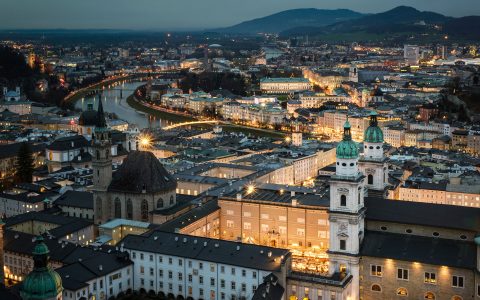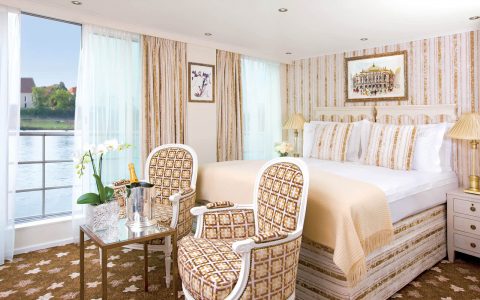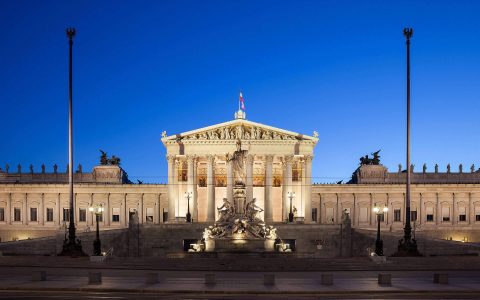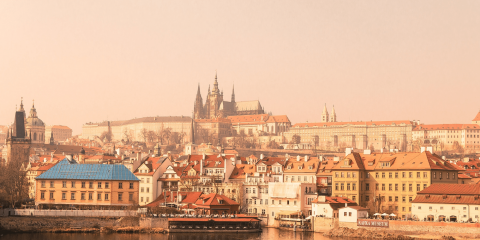9 Must-Sees Along the Danube River
 Once the frontier of the mighty Roman Empire, the second-longest river in Europe originates in the Black Forest of Germany, and flows for 2,730 kilometres (1,700 miles) southeast, ending at the Black Sea. The Danube passes through or touches the borders of ten countries, flowing through four capital cities on its path. One of the most fascinating waterways in Europe, here are just a few of the highlights that await you.
Once the frontier of the mighty Roman Empire, the second-longest river in Europe originates in the Black Forest of Germany, and flows for 2,730 kilometres (1,700 miles) southeast, ending at the Black Sea. The Danube passes through or touches the borders of ten countries, flowing through four capital cities on its path. One of the most fascinating waterways in Europe, here are just a few of the highlights that await you.

 The Proud Capital of Bavaria: Munich, Germany
The Proud Capital of Bavaria: Munich, Germany
While Berlin is the official capital of reunified Germany, Munich occupies a capital distinction of its own, being the capital of the federal state of Bavaria. Originally a duchy established in the 6thC, it became its own independent Kingdom of Bavaria (1806-1918). Within the region, its own quirks (a majority Catholic state in contrast to the Protestants surrounding them) and culture (this is where the tradition of Oktoberfest began) set it apart from the rest of Germany—not to mention its outstanding football team, the best in Germany, FC Bayern Munich.
Canon of Classical Music: The Blue Danube Waltz in Vienna
The Austrian composer Johann Strauss II gave the world a classical music standard (and a number of pop culture references) with the waltz “An der schönen blauen Donau” (‘By the Beautiful Blue Danube’). A lukewarm reception ensued upon its initial performance, but once it was debuted in an orchestral version at the 1867 Paris World’s Fair, the song by ‘the Waltz King’ became a worldwide sensation. Known as an unofficial Austrian national anthem, it’s also impossible to escape this song, especially in Vienna, the most liveable capital city in Europe and, indeed, the world.

 The Sharpest Sword in the Armoury: Passau, Germany
The Sharpest Sword in the Armoury: Passau, Germany
This southern Bavarian town is also known as the Dreiflüssestadt, ‘city of three rivers’, thanks to the confluence of the Danube, the Inn, and the Ilz rivers. While it is today a relatively quiet university town of 50,000 inhabitants, Passau’s influence in the Renaissance era was as a renowned centre of swords and bladed weapons. To own a sword from Passau’s skilled smiths, usually stamped with the city’s emblem—the wolf (from the city’s coat of arms), was to perhaps endow oneself with the bloodthirsty (and winning) qualities of the wolf on the battlefield. The ‘brand’ of Passau’s swords were well-known, and other towns (namely Solingen, another town that produced prized blades and swords) copied its wolf trademark for their own wares.
Culture with a Side of Cake: Linz, Austria
Austria’s third-largest city boasts its status as a European Capital of Culture (2009) and a creative city in the media arts recognized by UNESCO (2014). Make your way to the cultural mile in the city to see cutting-edge architecture and art in the city amongst its stately old buildings. The future is here in Linz, including a number of museums and performing art venues: the striking Lentos Art Museum (with works by Klimt and Schiele), the Brucknerhaus, the Musiktheatre am Volksgarten (opera house) and the Ars Electronica museum, highlighting the technological change now present in our world. While the university town was founded by the Romans, those with a sweet tooth will also be pleased to enjoy the famous Austrian cake, the Linzer torte, which is the oldest cake in the world (with the earliest recipe dating back to 1653)!

 Wachau Drinking? The Danube’s Premier Wine Region
Wachau Drinking? The Danube’s Premier Wine Region
The mighty Wachau Valley is where all our favourite drinkables can be found, namely the region’s exemplary Grüner Veltliner wine. Just about an hour’s drive away from Vienna, we have the Celts to thank for first cultivating the wild vines. Sample your way through the region’s offerings for pure pleasure on the palate.
When It Comes to Monasteries, Go Baroque or Go Home in Austria
Let us not forget that oft-quoted saying, “The bigger the monastery, the closer to God.” (That’s a real saying, right?) It certainly applies to the massive Melk Abbey. This imposingly Baroque creation dates from the year 1089 when Margrave Leopold II of Austria gave one of his castles to Benedictine monks, who eagerly transformed it into one of the centres of monastic life in Austria. Another place of enlightenment is the equally gorgeous (and Baroque) Klosterneuberg Abbey overlooking the Danube. Consecrated in 1136 by Margrave Leopold III (the son of the aforementioned Leopold II), it has survived an Ottoman siege (among others) and is filled with a series of Byzantine-inspired gilded copper plates at its magnificent altar.

Scheduled River Cruise Group Biking Trip
Four countries, three world capitals, and a slew of historic medieval strongholds, modern art museums and towering castle ruins along the way—oh, and did we mention wine country? On our Danube River Cruise Biking trip, see the best of Mitteleuropa.
DETAILED ITINERARYThe Emerging Heart of Central Europe: Bratislava, Slovakia
With a charming Old Town and inescapable views of Bratislava Castle sitting sentry above the Danube, Slovakia’s capital makes for an utterly pleasant visit. This underrated city of 450,000 is often overshadowed by its neighbours in Austria and the Czech Republic, but it’s a true gem of Central Europe. A walkable city fringed by forests, complete with beautiful hiking and biking paths along the Danube, Bratislava also has some interesting buildings such as the Little Blue Church, remnants of Communist-era architecture and a less crowded, more authentic vibe than larger cities on the tourist trail.

Panoramic Views and Prayers: Esztergom, Hungary
While its name may not roll off your tongue, there is one building in the city of Esztergom that is not to be missed: the impressive Esztergom Basilica, consecrated in 1856. The largest church and the tallest building in Hungary, with its dome standing about 72 metres (235 feet tall), it is the seat of the Catholic Church in Hungary. Its gigantic bell, when rung, can be heard for miles around, and from the top of the dome, visitors will be able to see the Danube valley and several mountain ranges. Within, you will find the largest painting in the world on the altarpiece—the Italian painter Grigoletti’s version of the Assumption of Virgin Mary, measuring 13.5 by 6.6 metres (44 feet by 22 feet)!

A Bathing Beauty: Budapest, Hungary
The elegant Hungarian capital is also known as “the pearl of the Renaissance”. From its astonishing Parliament building to the massive Buda Castle, and a fantasy mishmash of architectural styles from neo-Gothic to Baroque, Romantic and more, your eyes (and camera) will be delighted in this visually striking city. Uniquely Hungarian and soothing for your other senses are the therapeutic mineral waters found all around town—here’s our guide to navigating them.

MORE FROM Europe + Austria

Reading for the Road: A Few of Our Favourite Books About Austria
Austria
An Insider’s Guide to Vienna
Austria
Top 5 Driving Routes in Germany, Austria & Switzerland
Austria
An Insider’s Guide to Salzburg
Austria
Vienna’s Christmas Markets
Austria
Notes From the Road: The Unabashed Charm of Bavaria
Austria
8 Reasons Why You MUST Visit Lake Neusiedl
Austria
Butterfield & Robinson’s new cycling tour
Austria
Butterfield & Robinson Danube Biking Cruise
Austria
Butterfield & Robinson Recreates First Ever Cycling Trip To Celebrate 50th Anniversary
Austria
Butterfield & Robinson Introduces Biking River Cruise
Austria
River Cruises Get Active
Austria
4 Must-See Things to Do in Vienna That Reveal its Old World Charm
Austria
Notes from the Road: From Prague to Vienna, A Journey Through Time
Austria
Gruner Veltliner: Crown Prince of Austrian Wine
Austria
How to Order a Vienna Coffee
Austria
Vines 101: Austrian Wine from the Wachau Region
Austria
In Deep: Vienna
Austria
